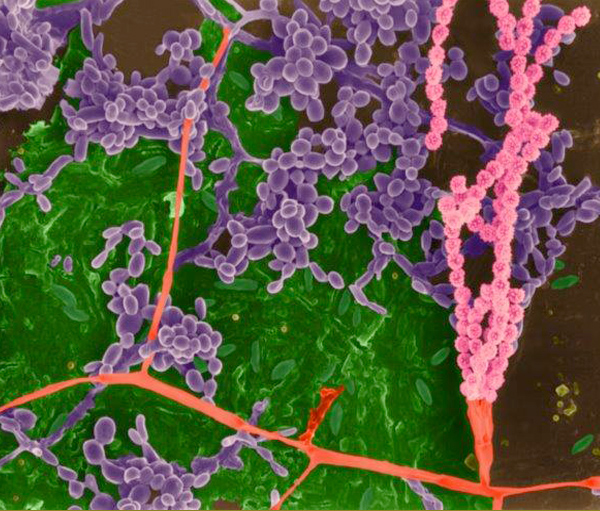
© Dennis Kunkel Microscopy
Home Resources Pathogens What is Clostridium botulinum?
What is Clostridium botulinum?

© Dennis Kunkel Microscopy
Clostridium botulinum is a Gram-positive, spore-forming, obligate, motile, anaerobic rod shaped bacterium.
What is botulism?
Botulism is a serious, but rare intoxication caused by preformed neurotoxins produced by Clostridium botulinum. There are three different forms of botulism:
- Foodborne botulism - Results from ingestion of preformed neurotoxins, commonly from foods that placed in anaerobic storage such as in cans or jars. Commonly implicated food products are inadequately processed, home canned foods. However, outbreaks in the US have also included various meat products, canned vegetables and salted or smoked seafood products.
- Infant/Intestinal botulism - Usually affects infants and rarely, adults with altered gastrointestinal anatomy or microflora. It is caused by ingesting spores of the botulinum bacteria that multiply in the gut and produce the toxin.
- Wound botulism - Occurs when an open wound is contaminated with botulinum spores.
What other diseases are caused by Clostridium species?
Members of the Clostridium genus are usually ubiquitous in nature. C. tetani releases an exotoxin causing tetanus and lock jaw. C. perfringes is usually acquired from dirt via open wounds. C. perfringes spores produce an exotoxin that causes gas necrosis of the infected area. C. difficile, is usually a part of the normal intestinal flora, and causes disease only when broad spectrum antibiotics such as Clindamycin deplete the other gut microflora. C. difficile then releases exotoxins that cause diarrhea.
Who is more susceptible to infection from Clostridium botulinum?
Susceptibility is general for both the foodborne and wound botulism. Most patients with infant/ intestinal variety are children between ages 2 weeks and 1 year. Rarely adults with altered gut flora either due to certain diseases, genetic susceptibility or improper antibiotic treatment are also affected.
Epidemiology of Clostridium botulinum
Botulinum spores are ubiquitous in the soil worldwide. Botulism toxin causes flaccid paralysis by blocking motor nerve terminals at the myoneural junction. The paralysis progresses in a downward fashion, affecting the eyes and face, throat, chest and extremities and eventually causing respiratory paralysis and death.
Incubation Period
Foodborne botulism usually produces neurologic symptoms within 12-36 hours of ingestion, but could also take up to several days. Generally, the shorter incubation periods are associated with severe diseases and higher case-fatality rates.
Diagnosis
The history and physical examination is usually the first step in diagnosing botulism. However, nerve conduction studies (EMG), spinal fluid examinations and brain scans are helpful. Botulinum bacteria can be isolated from the stool of infected people in the foodborne and infant variety of the disease.
Treatment of botulism
Foodborne botulism - If diagnosed early, antitoxin should be administered to block the actions of the exotoxin. If respiratory failure has set in, mechanical ventilator and intensive care is required.
Infant botulism - Remove the contaminated food by inducing vomiting and enemas. Good supportive care is further required for recovery.
Wound botulism - Administration of antitoxins to neutralize the exotoxin, surgical debridement and excision of the effected area, followed by the required supportive treatment.
Contact EHA Consulting Group today for more information about how we can assist your company.
We offer services for
- Retail Food Safety
- Restaurant Food Safety
- Manufacturers
- Food Trucks
- Drugs & Cosmetics
- Melons & Cantaloupes
- Produce
- Warehouses
- Food Packaging & Packaging Materials